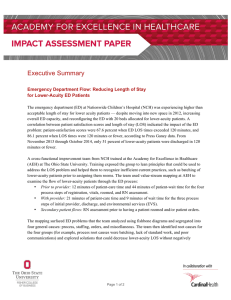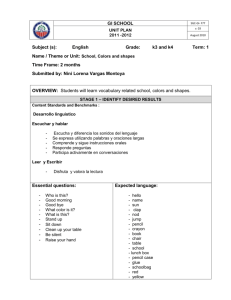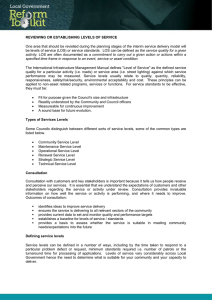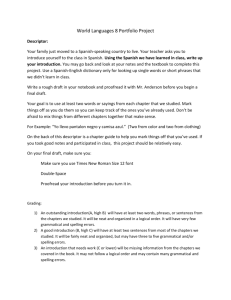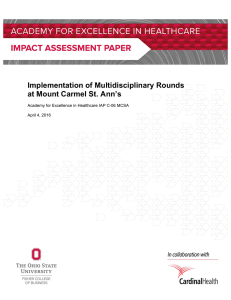Executive Summary Implementation of Multidisciplinary Rounds at Mount Carmel St. Ann’s
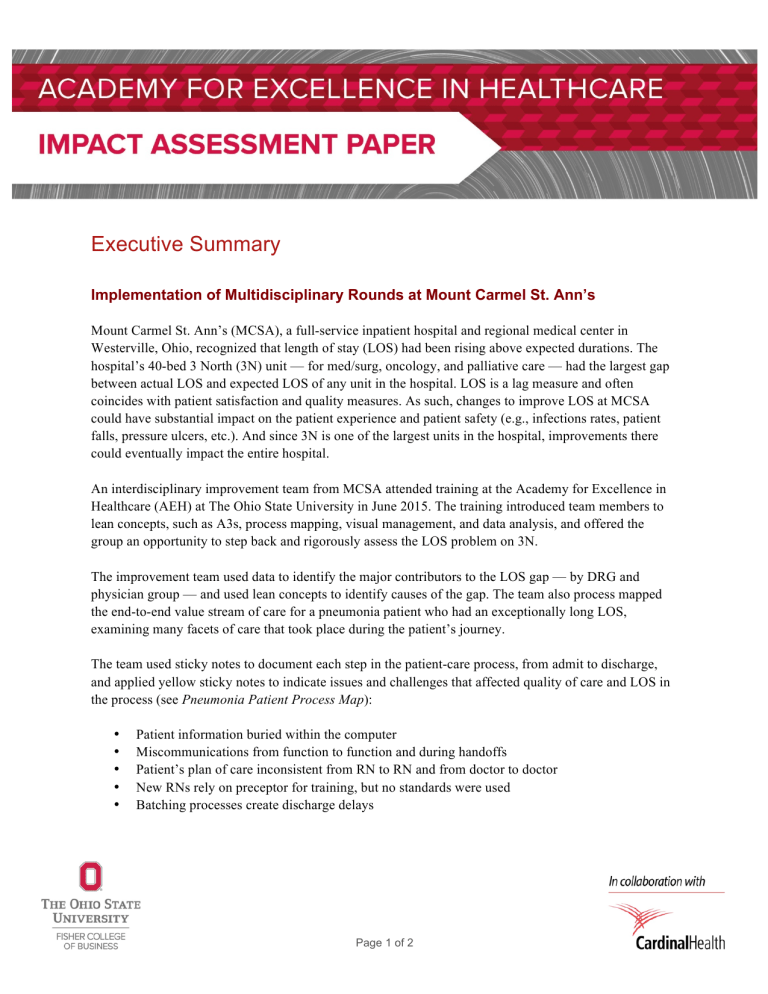
Executive Summary
Implementation of Multidisciplinary Rounds at Mount Carmel St. Ann’s
Mount Carmel St. Ann’s (MCSA), a full-service inpatient hospital and regional medical center in
Westerville, Ohio, recognized that length of stay (LOS) had been rising above expected durations. The hospital’s 40-bed 3 North (3N) unit — for med/surg, oncology, and palliative care — had the largest gap between actual LOS and expected LOS of any unit in the hospital. LOS is a lag measure and often coincides with patient satisfaction and quality measures. As such, changes to improve LOS at MCSA could have substantial impact on the patient experience and patient safety (e.g., infections rates, patient falls, pressure ulcers, etc.). And since 3N is one of the largest units in the hospital, improvements there could eventually impact the entire hospital.
An interdisciplinary improvement team from MCSA attended training at the Academy for Excellence in
Healthcare (AEH) at The Ohio State University in June 2015. The training introduced team members to lean concepts, such as A3s, process mapping, visual management, and data analysis, and offered the group an opportunity to step back and rigorously assess the LOS problem on 3N.
The improvement team used data to identify the major contributors to the LOS gap — by DRG and physician group — and used lean concepts to identify causes of the gap. The team also process mapped the end-to-end value stream of care for a pneumonia patient who had an exceptionally long LOS, examining many facets of care that took place during the patient’s journey.
The team used sticky notes to document each step in the patient-care process, from admit to discharge, and applied yellow sticky notes to indicate issues and challenges that affected quality of care and LOS in the process (see Pneumonia Patient Process Map ):
• Patient information buried within the computer
• Miscommunications from function to function and during handoffs
• Patient’s plan of care inconsistent from RN to RN and from doctor to doctor
• New RNs rely on preceptor for training, but no standards were used
• Batching processes create discharge delays
Page 1 of 2
Pneumonia Patient Process Map
Source: Mount Carmel St. Ann’s
Communication and discharge-planning issues were the most prevalent LOS causes, so the team focused their development and implementation of countermeasures on the following:
• Multidisciplinary rounds (MDRs): With all disciplines, including physicians, involved in a patient’s care in attendance, a multidisciplinary group discusses the patient’s plan of care for the next 24 hours, the discharge date, and unmet requirements that could delay discharge.
• MDR visual board: The MDRs take place in front of an MDR visual board, where key quality and safety information for each patient is updated regularly and displayed on the board.
• Discharge checklists: Standard work and tasks are identified for various roles to ensure that patient activities stay on track for their discharge date.
•
Elimination of batching: Staff focus on an individual patient’s discharge and other care requirements, rather than batching activities for a group of patients.
The team established a goal to reduce LOS for pneumonia patients by 20 percent: by September 2015, the
3N project had reduced LOS by 28 percent; in October and November the actual LOS was lower than the expected LOS. This performance can result in annual savings of more than $660,000 for the hospital, and the improved quality of care and patient safety and satisfaction were reflected in Press Ganey scores for
MCSA 3N, which rose dramatically from June 2015 to October 2015 for rate hospital (50.0 to 89.7); communication with nurse s (69.2 to 96.6); and communication with doctors (67.5 to 82.1). The project results have led to the rollout of the countermeasures across MCSA and to other Mount Carmel hospitals.
Read the full study of the Implementation of Multidisciplinary Rounds project , which illustrates that all disciplines involved in a problem must be aware of issues, underlying causes, and how their role contributed to outcomes. The project also shows how the team relied on data — to focus the project, pilot countermeasures, track effectiveness, and communicate and promote the efficacy of their work. This project also shows how to address batching, a problem that affects most healthcare processes.
About the Academy for Excellence in Healthcare: AEH blends in-person class time with hands-on project work, interactive simulations, and recurrent coaching, all aimed at helping healthcare teams spark actionable change at their organization. To learn more about AEH, contact
Margaret Pennington , Faculty Director, or Beth Miller , Program Director.
Page 2 of 2
